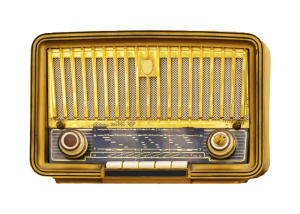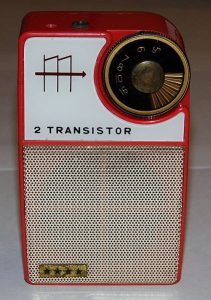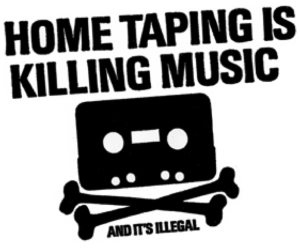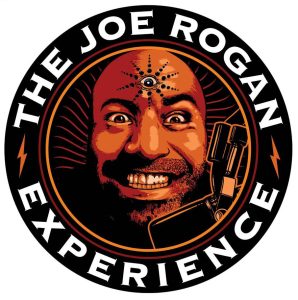11 Radio and Audio
By Dave Bostwick
If you’re like many Americans, you are likely to listen to radio in a vehicle or while shopping in a store that has a radio station playing softly on overhead speakers. Today, radio is often in the background, but it wasn’t always that way.
Watch the scene below from A Christmas Story. It helps illustrate the Golden Age of Radio (approximately 1925 to 1950) when a radio receiver was a dominant form of entertainment, and the radio itself was a vital piece of furniture in many American living rooms. It also shows us that complaints about misleading ads and “crummy” commercials didn’t start with television.
In this chapter, you’ll gain an overview of radio’s place in the mass media landscape from the early 1900s to today. We’ll also briefly look at how advancements in audio recording technology impacted the evolution of radio.
YOUR MEDIA LANDSCAPE
In 2023, Spotify introduced the personalized disc jockey (DJ) powered by artificial intelligence. Spotify promotional text said, “The DJ knows you and your music taste so well that it will scan the latest releases we know you’ll like, or take you back to that nostalgic playlist you had on repeat last year.”
Do you classify this as radio?
EARLY EVOLUTION OF RADIO
The early days of radio’s development facilitated point-to-point communication, especially for ship-to-ship messages. Radio did not begin as a commercial platform for mass communications.
The Radio Act of 1912 required all wireless operators to obtain a broadcast license from the federal government. The legislation was partly a reaction to the sinking of the Titanic. According to one government website, “Following the Titanic investigation, which found that radio interference contributed to delays in rescue operations, Congress began regulating transmissions with the Radio Act of 1912.”
 A few years later, though, companies began exploring the potential for radio as a mass medium. In 1920, Westinghouse set up the first commercial broadcast station (KDKA in Pittsburgh) partly as a way to sell more radio receivers. AT&T began airing advertisements (called toll radio) on its radio stations in 1922. Until then, people viewed radio as a public information service.
A few years later, though, companies began exploring the potential for radio as a mass medium. In 1920, Westinghouse set up the first commercial broadcast station (KDKA in Pittsburgh) partly as a way to sell more radio receivers. AT&T began airing advertisements (called toll radio) on its radio stations in 1922. Until then, people viewed radio as a public information service.
An article from Harvard’s Nieman Lab describes how a magazine in 1924 published a contest asking, “Who is to pay for broadcasting and how?” (A century and many disruptive digital technologies later, we can ask the same question.)
By 1925, more than 5 million radio sets were in use across America, and there were hundreds of stations.
The Radio Act of 1927, which later evolved into the Federal Communications Act of 1934, said that licensees did not own their channels but could license them as long as they served the “public interest, convenience or necessity.”
The Federal Radio Commission, established for industry oversight in 1927, eventually became the Federal Communications Commission of today.
THE ADVENT OF RADIO SHOWS
The following video provides a brief overview of radio’s heyday in 1930s.
Many of the first television programs, including soap operas and situation comedies, began as radio shows. Soap operas gained their name because, in some cases, a soap company would sponsor an entire weekly drama.
The Guiding Light was the most prominent soap-opera example, debuting on radio in 1937. According to Smithsonian Magazine, the show premiered as a 15-minute radio spot and then became a half-hour television program in 1952. When it was cancelled after 72 years in 2009, it was an hour-long show owned by Procter & Gamble.
For a sense of entertainment in the Golden Age of Radio, listen to an episode of The Shadow (or at least listen to the first few minutes). The show featured this question for its catchphrase: “Who knows what evil lurks in the hearts of men?”
If you want more perspective, a video from the Needham Channel chronicles early radio programming and shows how several early radio shows were recorded before live audiences.
On the news side, as radio stations began competing with established newspapers for audiences, publishers began feeling threatened and sought to protect their print product. In his book The Gutenberg Parenthesis, Jeff Jarvis wrote, “Newspaper publishers tried to disadvantage their new competitors, strong-arming radio executives to agree to abandon news gathering, to buy and use only reports supplied by three wire services, to limit news bulletins to five minutes, and to sell no sponsorship of news.”
However, approximately two decades later, both radio and newspapers would be threatened by a new media technology: television.
THE IMPACT OF TELEVISION
 Beginning in the 1950s, when TV began taking radio’s program ideas and sponsors, radio became dependent on recorded music to survive. Playing recorded music was much cheaper than paying voice actors and technicians to produce original radio content. Thus began a marriage of the radio and sound-recording industries
Beginning in the 1950s, when TV began taking radio’s program ideas and sponsors, radio became dependent on recorded music to survive. Playing recorded music was much cheaper than paying voice actors and technicians to produce original radio content. Thus began a marriage of the radio and sound-recording industries
Luckily for the radio industry, Texas Instruments marketed the first transistor radios in 1953. Because transistor radios were much smaller, they could go places where television could not.
According to Car and Driver‘s timeline of the history of car radios, the first all-transistor car radio debuted in 1963. When they weren’t listening in their vehicles, consumers could carry small portable transistor radios to the beach or the park, where they could listen to stations that played recorded music.
As a cost-cutting measure today, radio disc jockeys often have recorded their audio in advance. During overnight hours and weekends, many smaller radio outlets pre-program their content so that no one is actually broadcasting live or working at the station.
EVOLUTION OF SOUND RECORDING
Because radio relies on audio, it’s difficult to study radio in isolation. Let’s take a quick detour here to look at a condensed timeline of sound-recording technology.
Study the following presentation slides by using the forward button or clicking on sections of the control bar. To enlarge any interactive presentation in this book, click on the lower-right full-screen option (arrows).
And for a video re-enactment of what Thomas Edison’s initial experiment with tinfoil phonograph might have looked like, you can watch the following excerpt from the 1940 movie Edison, the Man, which starred Spencer Tracy.
MUSIC PIRACY
As audio recording technologies have evolved, so too have industry concerns about music theft. Pirated music involves copying and distributing recorded music without the consent of the copyright owner. Following are a few examples from the past 60 years.

FM Radio to Cassette Tape – In the 1970s and early 1980s, some FM radio stations in the United States and beyond would attract listeners by playing entire albums uninterrupted by advertising. Station directors knew that audience members could record those albums on cassette tapes and thus avoid buying the albums. Beyond FM radio, one consumer could buy an album and then record cassette copies for friends.
Ripping from CDs – As compact discs (CDs) became popular, piracy went digital. Some tech-savvy music enthusiasts experimented with ripping or transferring songs from CDs to computers and other electronic devices, prompting a few copyright battles along the way.
Napster and P2P – Fast-forward to 1999 when the peer-to-peer file-sharing service Napster was launched and soon gained widespread popularity. Napster users could download and share digital music files with others. Eventually, the Recording Industry Association of America (RIAA) won a series of court cases that led to Napster’s music-sharing service being shut down in 2001.
Ripping from YouTube – Although Napster is no longer an industry concern, music piracy still exists today. The research firm Muso reported a steady global increase in music piracy, especially involving websites that rip audio from YouTube videos and then convert that audio into downloadable music files.
For a more complete summary, you can visit the website for History of Music Piracy – A Brief Explanation.
RADIO CONGLOMERATES
Most local radio stations are now owned by conglomerates. Here are three of today’s prominent conglomerates. You can use these links to find stations they own in geographic regions:
- Audacy (scroll down the page to browse by market)
- Cumulus
- iHeart (iHeart owns many stations and may also provide streaming services for additional stations.)
Conglomerates typically own several stations with various formats in the same market, and these stations’ operations can be housed in the same building, thus reducing operating expenses. Plus, sales executives can offer ad packages with multiple stations catering to a local business’s target demographics.
In an example of the ever-changing market dynamics of the media industry, Audacy emerged from bankruptcy in 2024 and subsequently laid off hundreds of workers in early 2025. Similarly, iHeart Radio went through the bankruptcy process in 2018-19, while Cumulus survived bankruptcy in 2017-18. Nevertheless, Cumulus and iHeart laid off employees in late 2024 through 2025.
Here are some of today’s most common radio-station formats:
-
- Country
- News/Talk
- Religion/Christian
- Spanish
- Classic Rock
- Sports
- Top 40
- Adult Contemporary
FM vs. AM
You’re probably familiar with the terms AM and FM to describe radio stations. AM stands for amplitude modulation, while FM stands for frequency modulation.
Next, you can consider this related flip-card question.
Early U.S. radio stations used AM. Although the first FM radio station debuted in 1936, FM didn’t gain popularity until the ’50s and ’60s, when FM signals could be broadcast in stereo. For a more-detailed explanation, you can visit ScienceABC.
When some automakers stopped selling vehicles with AM radios in 2024, Congress began considering variations of an AM Radio for Every Vehicle Act, which would require all automakers to install AM radios as a matter of public interest.
THE RISE OF PODCASTS
Podcasts have become increasingly popular, especially for younger listeners. According to Edison Research, approximately half of Americans age 12+ listen to podcasts at least once a month.

Some listeners/viewers play podcasts in the background of their daily routines, and several of the most popular podcasts last an hour or more and are also available in a video format.
New York Times writer Joseph Bernstein wrote that “if cable news is the background noise of choice for many boomers, video podcasts have the potential to become the same for younger audiences, who often consume media with a smartphone in hand.”
Also, portions of a long-form podcast are often extracted for short clips on short-content platforms such as TikTok, Facebook or Instagram Reels.
CLOSING TIDBITS
Here are two statistical factoids to wrap up this chapter.
- According to the Pew Research Center, approximately eight in 10 Americans age 12 and older listen to AM or FM radio in a given week.
- Now that more consumers stream popular music rather than buying albums or downloading individual songs, musicians aren’t sharing in streaming riches. For example, if an artist on Spotify makes in the vicinity $0.004 each time a song is streamed, this translates to $4 for 1,000 streams. To make $400, the artist would need 100,000 streams.
FILL IN THE BLANKS
RADIO MARKET ANALYSIS
Choose a metro area either nearest to where you live or one that interests you, and list the area’s radio stations. The conglomerate links are a starting point.
- Audacy (scroll down the page to browse by market)
- Cumulus
- iHeart (iHeart owns many stations and may also provide streaming services for additional stations.)
With additional research, you may find there are additional area stations not owned by these three conglomerates.
For your assignment, include the following two parts.
Part A – List at least 8 stations in that metro area along with each station’s format and ownership. Your list of stations in that metro area should include at least two conglomerates.
(For example, your selected metro area could include stations owned by Audacy along with other stations owned by iHeart. Or your list could include stations owned separately by Audacy and Cumulus, iHeart and Cumulus, or all three conglomerates.)
Just be sure to select a metro area that has more than one radio conglomerate present in the market.
Part B – Write a brief analysis of the radio market in your chosen metro area.
- Do you think listeners and advertisers have an adequate number of choices?
- Are there any formats that seem to be missing?
- What was the most unexpected information that you found?
- Does it concern you that so many stations are owned by the same companies?
Write approximately two sentences per question in Part B.
ADDITIONAL SOURCES
- 100 Years of Radio – California Historical Radio Society
- Broadcasting – The History of Radio – Law Library
- Chronology: Technology and the Music Industry – PBS
- Radio Station Formats – Understanding Media and Culture
- The History of Car Radios – Car and Driver

